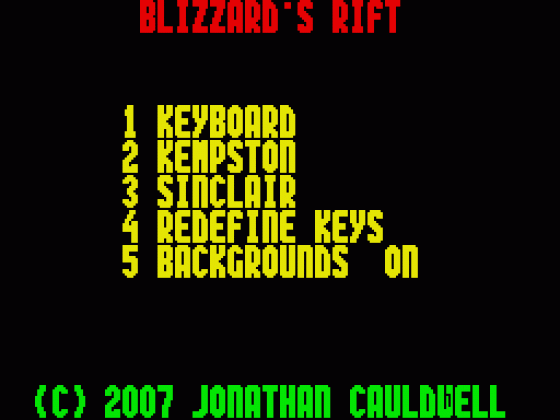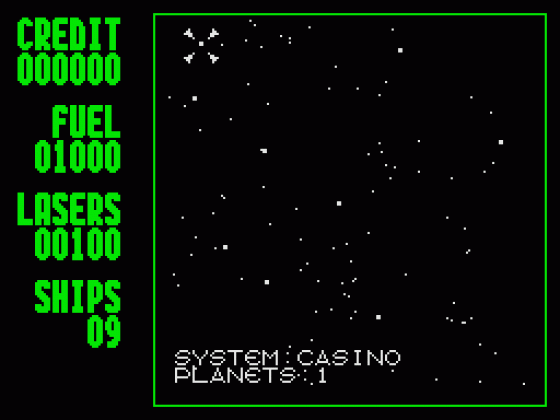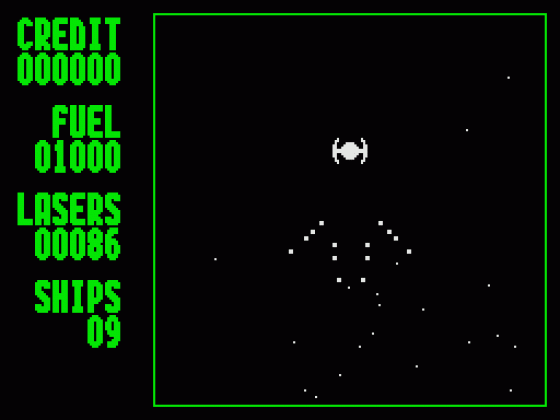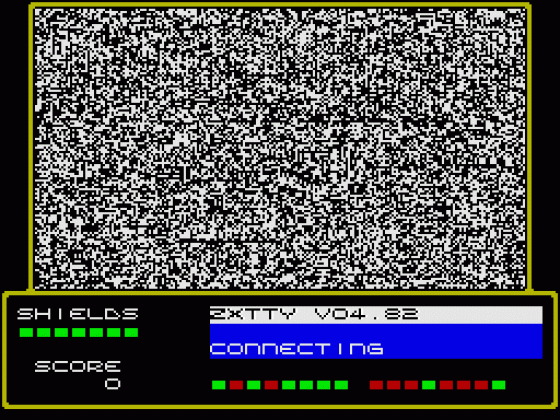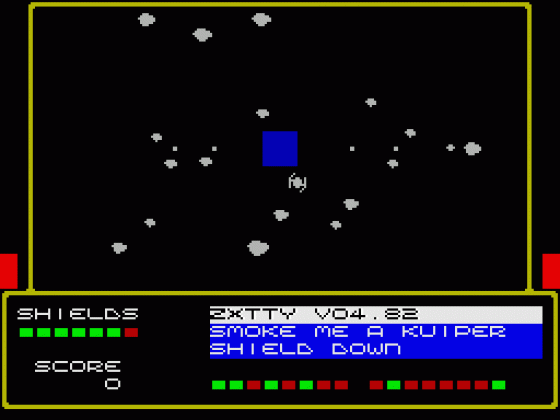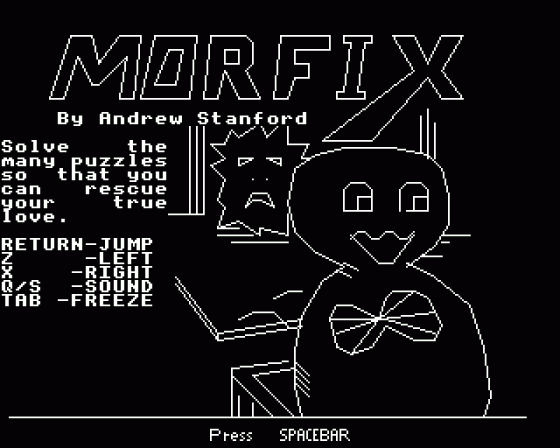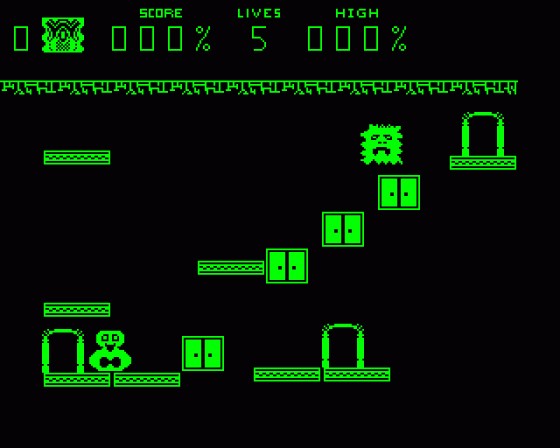
Micro Mart
 22nd July 2015
22nd July 2015
Alone in deep space sits Ace Commander Edwards, smoking his kuipers and eating seeds for breakfast before popping a magic pill to take his waistline back down to 32". That's all happening in this month's round up of newly released retro games
Unwritten Rules
Over the past six months, we've looked at a fair slice of both new homebrew retro software and the archive sites that occasionally surprise us with some undiscovered long-thought-lost project. Along the way I have developed a set of so-far "unwritten rules" for what I will and will not include in it and, for those of you who have followed the development of this column, this month is as good as any to articulate those rules. So here they are:
Firstly, anything that appears in Retro Round-Up will, in my eyes, be a "quality" release. By that, I don't mean that it needs to be a physical tape or disc, but rather that it must be a release that its author has clearly put a great deal of time and effort into. Secondly, it must be a software release; I don't do hardware simply because I collect and own everything I review and software is my thing; I don't have the space to store hardware too. Thirdly, the Retro Round-Up will only feature reviews of completed, by which I mean finished, software. That is simply because I have, over the years, been disappointed myself too many times by projects that were started, gained a lot of buzz and then were suddenly abandoned. Fourthly, the software appearing here must be available - whether that's via a web site or an e-mail address.
Now, with all of the above in mind, therefore, you'll remember that last month's article ended with a promise that this month's Retro Round-Up would be taking a look at some of the newly re-discovered software for the Dragon 32. However, we won't be looking at it this month after all. So far, unfortunately, none of that software meets the very first condition and so it just doesn't feel right to include it.
This raises a very interesting point about retro software per se. In the thirty years since Dragons and BBCs graced our homes, software has come a long way. In the early Eighties, software programmers could get away with spending two hours writing a Basic Pac Man game and flog it for £10 a pop. The archive sites have gathered up all of these clones and made them available for free - so the "market" for them, if there ever was one, is simply saturated. Those who are interested in new games for such formats both want to see something different and something which reflects, in its production, what we've learned about game development in the interim period. "Lazy" basic games just will not do. In fact, if you released one today, you would probably just get laughed at.
Now that's not to say that everything recently released for the Dragon is not good quality. It's more that this has been yet another bumper month for new releases, with Cronosoft leading the charge with three new Spectrum games, all available for less than the cost of a bus ticket. And with their quality level being superior, let's take a look at them now...
Blizzard's Rift
Blizzard's Rift is a new release for the Spectrum 128K and it has been released as the main game on a double-sided cassette by Cronosoft. The flipside contains a second game, Kuiper Pursuit. Both games are somewhat similar in style and, as per most of Cronosoft's catalogue, are written by Jonathan Cauldwell.
Blizzard's Rift could be summed up as "Elite with the space-trading replaced with Thrust-style caverns" which is both a compliment and, regrettably, an admission as to its lack of originality.
You begin each game by paging through star charts and choosing a "destination planet". Confirming this engages your ion drive and pits you in a cockpit-based first person shooter in deep space. You can bank anticlockwise and clockwise, climb and fire. Intermittent alien ships appear and must be manoeuvred into the centre of your cockpit view before you press the fire button. A stream of bullets then stream towards where you were aiming.
As you would expect from a craft journeying through space, scattered dots around the playing area provide the impression of movement. Curiously though, these dots move slowly; in fact, I found myself thinking my craft was stationary and started looking for a non-existent accelerate control!
Deep space is home to other ships apart from yours but, weirdly for a game of this type, you don't actually have to shoot these marauders out of the sky. They, according to the instructions, "pose no threat to you" so the only reason for destroying them is to increase your score. Shooting is not instantaneous either; releasing lasers at your foes simply releases more dots into the playing area. Indeed, pressing fire is like releasing a stream of "dot-missiles" that glide toward their targets. As they move further into the distance, it is difficult to distinguish the missiles from the dots of deep space.
When journeying to your destination, note that it takes longer to travel to a distant planet than a local one. However long it takes, the game changes entirely on arrival and becomes a side-on Thrust challenge of craft control. You see, littering each planet's surface is an assortment of treasures. Each treasure can be collected by flying into it. However, the gun turrets firing at you, and the treacherous cavern walls that require traversing, make such planet-pillaging extremely difficult. It is presumably the caverns rather than the cockpit-dogfighting game that restrict Blizzard to the 128K Spectrum; each planet has its own unique layout, and the planet's proximity to your start position is in no way commensurate with its difficulty level.
The pace of the game and, as you pick your nemeses off, the satisfaction of them exploding into dust (more dots!) are good things about Blizzard. Unfortunately, these do not offset its frustrations. Firstly, even with the Elite-style ability to upgrade your ship, making gamers journey through a pretty dull deep-space adventure just to play Thrust is rather a dubious premise. Most players are hopeless at Thrust anyway - the finite angling and nudging of controls required seems them loopy in five minutes flat! Finally, if you consider that, when you crash in the Thrust style game, you are returned all the way back to the planet's surface again (no matter how far you had progressed) it doesn't sound too good, does it?
Kuiper Pursuit
On then, to Kuiper Pursuit, and those of you of a certain age (Mine!) may remember the TV programme Red Dwarf and Commander Ace Rimmer, deep space adventurer extraordinaire, who announced each mission with the phrase "Smoke me a kipper. I'll be back for breakfast." Kuiper Pursuit, has an early nod to Ace, with the on-board cockpit-computer scrolling "Smoke me a Kuiper".
The aim, as you might have gathered, is to shoot down enemy ships. However, Kuiper's deep space is significantly more challenging as it is peppered by flying asteroids. You must try to avoid these and shoot down as many kuipers as you can before your own seven shields run out. Your on-board computer spits out "Shield Down" each time one is wiped out, and encouraging compliments like "Bullseye! He's bought it!" when your bullets find their quarry.
Nice though this is, you actually miss the majority of these comments though, because the game demands your unwavering attention. Avoiding a screen full of asteroids is hard enough to begin with, but the game's dynamics are such that you are "hit" by an asteroid if it reaches a certain size and is somewhere in the middle of the screen. Unlike in other deep space shoot-a-thons, this certain size is woefully small; an asteroid never even reaches the size that it obscures anything else at all. This can be rather confusing as the computer can be ratcheting up the "Shield Down" messages for a good while before you get the hang of exactly how this part of the game works. When you are hit, the action slows down so that you can correct your position. During the entire playing time of Kuiper, the Spectrum emits a rather piercing stream of white noise, which is only interrupted by the sound of your lasers firing off. Firing is the same dot-missile effect as in Blizzard, and you dive as well as climb here. However, there's no option to upgrade your firepower and there's little "hook" factor to Kuiper Pursuit. A typical bout lasts about two minutes, which will land you a place in the high score table too.
The only other point to make is that if you're a fan of Yerzmyey, the Spectrum music coder, Kuiper Pursuit contains a digitised musical intro by him.
It's easy to think that the 128K Blizzard's Rift is the main attraction of this compilation, with 48K Kuiper Pursuit just thrown in as a bonus game. However, that's not really the case. The two games were written years apart and as separate professional titles in their own right. For £2 a game, and considering the whole package comes on cassette with some splendid cover art, I really cannot criticize them too harshly. If you're a fan of deep space shooters, and have played Elite to death, then what are you waiting for? Visit cronosoft.orgfree.com now!
Morfix
One of the best archive sites for retro games is Stairway To Hell (www.stairwaytohell.com) which is maintained by the same team as retrosoftware.co.uk. It features a near-complete library of every game ever released for the BBC Micro. Over the years, it has also found more than a few hitherto-unreleased ones too. Morfix, written by Andrew Stanford, is one of these and is a monochrome graphic adventure that I suspect few have seen - a shame, because it's rather unique in style.
You take control of a blob and your mission is to reach your girlfriend (another blob), situated in one of the many "rooms". You have only three controls - left, right and jump. When you want to pick up an item, you must move over it.
Scattered around the rooms are some shapes including a circle, square, star and figure eight. Movement of your blob involves rolling him, and contact with any of the shapes results in him morphing into that same shape (although his smiley face remains constant). You need to be a certain shape to get through the doors that correspond to that shape's outline. Mission one therefore is to make a map - so you can see, at a glance, what shape you need to be in which room. Otherwise, you'll waste lots of time trying to remember where each particular shape is located.
Mission two concerns the other items you will find. Smaller items can be picked up and carried. Larger items are those which require you to hold a corresponding smaller item. When you do, they increase the "percentage complete" in the top centre of the screen and allow you to make further progress. For example, taking the coin to the balloon machine will operate it. When it then releases a balloon you can climb on top of that balloon to reach a higher platform and a new room.
Finally, mission three is the obvious avoidance of the patrolling monsters that live in each room and are anxious to deplete one of your five lives. Morfix isn't particularly big and the solutions to its problems aren't particularly difficult. However, though I did manage to complete it on my eighth go, it did require thought, planning and a fair dose of arcade skill. That certainly deserves a recommendation when it is completely free of charge. It can be downloaded from Stairway To Hell and seen in action here.
Retro Find Of The Month - Farmer Jack And The Hedge Monkeys
When I was a boy, I owned an Acorn Electron game called Bumble Bee which was a twist on the Pac Man formula. Your bee scurried around a maze avoiding spiders and clearing screen after screen of dots. The twist however was that the maze walls would rotate if your bee rammed into them, effectively making the maze fluid. Scattered around it were a bunch of spider-traps too, and you scored bonus points if you managed to lure the roaming spiders into one of them. I always assumed Bumble Bee was an original game because there didn't seem to be any clones of the format for the Spectrum or Amstrad computers.
Now, many decades later, there is a very similar game for at least the Spectrum. Farmer Jack And The Hedge Monkeys is almost identical, replacing the bee with a tractor, dots with seeds and spiders with "ravers, hippies and hedge monkeys". It's a fast, frantic and frustrating version too with excellent graphics - and yet another musical masterpiece by Yerzmyey beating away in 128K mode.
The maze is of considerable size and you begin clearing it from its dead centre. Hippies also begin at the same position but appear one at a time and only when an on-screen countdown reaches zero hour. Needless to say, it's advisable to clear all seeds around the start position as quickly as possible. This will allow you to keep some space between you and them. Some walls will rotate about their origin if you run into them; others however will not. Moveable and immoveable walls are coloured differently, although you do need sharp eyesight to determine this.
Overall, with its gorgeous opening screens, its selection of funky music and its colourful graphics, Farmer Jack is really a very well put together title indeed. That is, however, apart from one big issue which I should warn you may result entirely from my overfamiliarity with Bumble Bee. That big issue is this: Your tractor can be moved left, right, up and down. However, if you release the control key, it stops. If you compare this behaviour with Bumble Bee, or indeed Pac Man, this behaviour is different. In those two games, you tap the control key and your character continues in that direction, bashing revolving walls out of the way if appropriate, until he hits a foe and dies or comes to a stop at the maze outer border. That is not so here.
Now whilst this seems like a little thing, it has a large effect on the frustration level of Farmer Jack. Your tractor must be "in line" with the maze walls to navigate its way through them. If you stop in an unaligned position, your tractor simply won't move as you want it to, and in the second it takes to shift it about, an angry hippy may well collide with you, taking away one of your three lives.
I'm sure Cronosoft would argue that this game is not Bumble Bee and the movement routine is a feature of what is a very addictive game. I would have to agree. But, even if I wasn't a Bumble Bee aficionado, I would, I think, still find fault that you can be thwarted in making progress through the maze by being a few pixels too far left or right. Still, if you set that aside, Farmer Jack is an excellent clone of the old favourite and highly deserving of the title of Retro Find of the Month.
Rounding Up
X-Force (for the Commodore 64) has just been released, with pre-orders being fulfilled by Psytronik (http://binaryzone.org/retrostore/) as you read this. The emulator version is also currently sitting in my Inbox. Next issue therefore, we'll be taking a look at this, and a whole host of new releases from the same company. Until then, however, keep avoiding those hippies and shooting down those kuipers...
Scores
(Spectrum 48K/128K)

